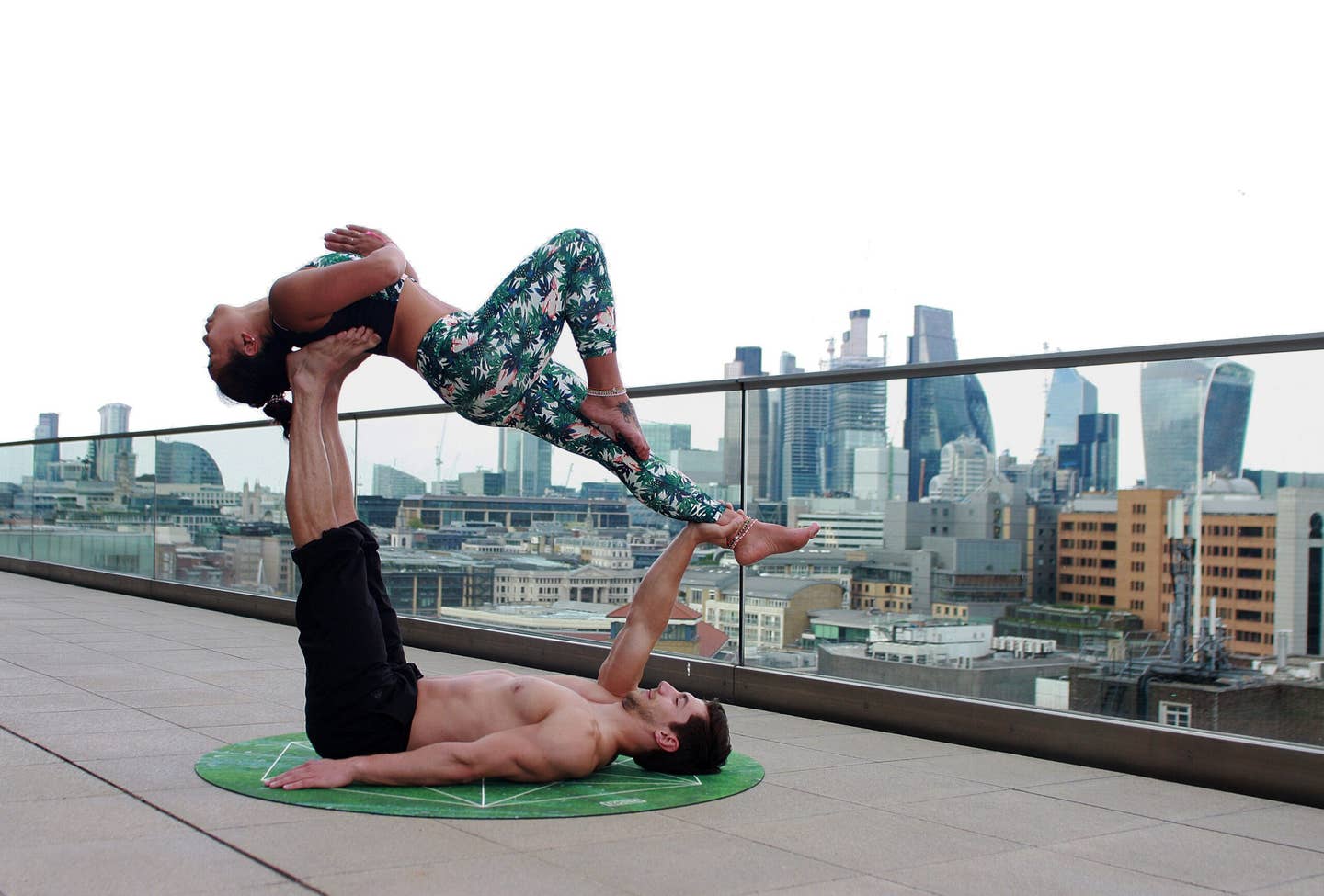
Go solo, with a live-in partner, or with a pet as you adapt your fitness routine for social distancing. The formfitness/Pexels
All around the world, people are finding creative ways to live their best lives while social distancing. Roving outdoors is a healthy option if you have access to large, uncrowded spaces—but you can also keep your fitness up by making an yard, alley, or bedroom floor your new playground.
Extreme times call for extreme measures. PopSci editors are helping to flatten the curve by bringing their nerdy gym regimens home. And sharing them with you, of course.
Read on for a few of our custom workouts.
If you do hot yoga, try this …
A long-time mat rat, DIY Assistant Editor Sandra Gutierrez has practiced Bikram Yoga—now controversial because of its infamous creator—for more than six years, and now makes due with YouTube videos in her tiny Brooklyn apartment.
Hot yoga is one of the hardest workouts to replicate at home mainly, because most people don’t just have a spare room conditioned to a constant temperature of 107.6 degrees Fahrenheit.
But this practice is just a selection of 26 hatha yoga postures and 2 breathing exercises made into a specific routine, so technically, they can really well be done at any temperature. One thing to keep in mind though—some of the more advanced versions of these postures are really straining on the tendons and joints, and not having hellish heat to soften your muscles means you have to be extra careful when trying to reach for your toes.
Equipment
- Yoga mat
- Towel (even without the heat, there’s a posture that requires it)
- Full-body mirror
- Comfortable and light clothes (you’ll still be sweating)
- Any device that can play YouTube
- Wireless earbuds (optional)
The drill
A good Bikram Yoga practice requires near-perfect postures, so listening to instructions is very important. Given that you won’t have a teacher around to correct you, practicing in front of a full-body mirror and focusing on the right form is crucial. This doesn’t mean you have to push yourself unnecessarily—do whatever you can, but do it in the proper way.
The main challenge of practicing the discipline at home is time. Bikram Yoga’s 26 postures are done in a routine that’s invariably 90 minutes long. If you have kids, it’s very unlikely you’ll get that much peace and quiet, unless you have a team-player spouse or another caregiver who’s willing to sacrifice themselves. If you do, honor them after your practice. If you don’t, be indulgent with yourself and stop as many times as you need.
For your practice choose somewhere spacious and quiet; if you can lay on your stomach with your arms extended to the sides and not touch anything, you’re good to go. Then pick your video. A quick search on YouTube will result in more than a handful of easy-to-follow videos. There are also a couple of studios giving classes on platforms like Instagram live right now (like my old studio in Santiago, which teaches in Spanish every day). Since you’ll be looking at your body in the mirror most of the time, don’t worry about image quality or how big your screen is. As long as you have earbuds on to listen in on the dialogues, you’ll be fine.
And practice! If you’re new to this, take it slow and throw in as many savasana breaks as you need. The next day you’ll be feeling muscles in your body you didn’t know existed. If you’ve done this for a while, please remember that you’re not nearly as flexible in a cold environment as you are in a hot yoga room—avoid injuries by listening to your body. It’s very likely you won’t be able to do advanced postures or bend as much as you usually do.
If you’re signed up for a race, try this ...
Flying’s Editor-in-Chief Julie Boatman had been training for her 20th marathon this spring. Now she’s switching course and planning for a virtual event.
When you’ve been training for months, the postponement or cancellation of your goal road race hits home, particularly if you’ve aimed for a half or full marathon. Your race director may have a virtual option for you, but what if there isn’t a planned event? You can set one up on your own or with a few friends to keep your dream alive—and stay in shape to combat the physical and mental health drains of stay-at-home restrictions.
You already have a spiritual leader in this: the guy who completed a marathon on his 23-foot-long balcony in France in six hours and 48 minutes. So there’s a concrete time to stride toward.
Equipment
- Running shoes
- Smartphone app like MapMyRun
- An app, measuring tape, or your foot to estimate distance
The drill
Find your course. The best ones take into consideration the lay of the land and have minimal turns to cut down the overall run time. Making fewer turns holds another benefit: reduced strain on your knees and other joints. No one wants an injury, ever, but you definitely don’t want to crowd the emergency room in these times.
Measure the distance in either meters or feet using whatever tool you have. Here’s a quick conversion chart:
- 5K = 5,000 meters = 16,404.2 feet
- 10K = 10,000 meters = 32,808.4 feet
- Half marathon = 21,097.5 meters = 69,217.5 feet
- Full marathon = 42,194.9 meters = 138,435 feet
One of the reasons to run road races is for the crowd interaction: The miles are a lot less lonely with your fan club there to support you. The advantage of a virtual event is that you can pick a time for people to cheer you on from wherever they are.
After you’re decided on a date, come up with the plan. If your course is outside (say, 1,730.4 laps around your backyard’s 80-foot perimeter) resist the temptation to scrub if the weather’s not perfect. Half the challenge of a real-time race is dealing with the conditions at hand. You’re not really testing yourself if you wait for the perfect time.
Finally, plan a reward. Did you finish? Beat an old record? Push through a tough part of the run? It’s worth diving into your quarantine snack stash—and that stockpile of adult beverages—to celebrate your success. Those are some unexpected odds you beat since you signed up for that race back in December.
If you’re a kettlebell fiend, try this ...
After Tech Editor Stan Horaczek’s CrossFit gym shut its doors during the pandemic, he turned to a friend and pro for a stand-in strength regimen.
A kettlebell is essentially a rock with a handle on it. It doesn’t have any moving parts you can break, and it doesn’t require any pricey accessories to go with it. Still, that simple weight enables some of the most wonderfully evil workouts you’ll ever accomplish. Baltimore-based trainer and certified kettlebell coach Laura Diebold provided the following workout specifically for PopSci.
Equipment
- Kettlebell. Note: If you’re just ordering your first bell or you’re a newcomer to the discipline, don’t get fooled by the weights, which may seem low. A 35-pound kettlebell can tax even the fittest and strongest athletes. Because they require dynamic movements, it’s best to err on the lighter side and make up the effort with increased volume.
The drill
Warm up with this half-kneeling kettlebell sequence. It’s short, only because the workout itself is long.
The workout should take about half an hour with reps every minute, on the minute—EMOM in CrossFit speak. For each exercise, perform 50 seconds of work followed by 10 seconds of rest and transition. When you finish the last exercise (kettlebell pull-overs), start back over with the first exercise (cheat clean with goblet squat). After 25 minutes, you will have completed five total rounds of each exercise.
Each round consists of:
- Cheat clean with goblet squats
- Z press
- Single arm swings (25 seconds with each arm)
- Plank pull-throughs
- Kettlebell pull-Overs
Adjust the work-to-rest ratio if you need. You might find that you can hold your form better with 40 seconds on and 20 seconds off, which is important if you don’t want to spend the rest of your social distancing laid up with an injury.
If you rock climb, try this …
Think it’s impossible to keep up your bouldering and top-roping skills at home? Think again. Whether you have a house or a studio apartment, Art Director Katie Belloff’s full-body routine should fit right into your day to day.
Outside of the warm up, abs, and cool down, it’s important to alternate exercises to avoid overworking your key climbing muscles. Here’s just one combination to get you started.
Equipment
- Resistance bands
- Pull-up bar
- Two dumbbells (any lighter weight)
- Yoga mat
- Door-frame hangboard (advanced)
The drill
A light yoga flow will help your control and stability on the wall. Start with 30 seconds of cat-cows to get your core active, then move to table-top. Flexing and lifting with your toes, lift your knees off the ground so they hover just six inches over your mat. Hold for 10 seconds. Push back into down dog and slowly lower into a plank position. If it’s too hard to hold yourself with straight arms, move so your forearms are resting on the mat under your shoulders. Hold for 30 seconds. Push back into your down dog and repeat this transition three times. You can end on twisting triangle pose on each side: Focus on keeping your shoulders in a straight line as you push your chest and arms out.
Climbers, you can never do too many ab workouts or leg exercises. Try the ones in the links with dumbbells each day and twice a week, respectively.
Now let’s get to the good stuff: your shoulders and back. With the pull-up bar, do a round of 10 scapular pull-ups and 10 regular pull-ups. If you have trouble doing the full set, grab a resistance band and hang it on the bar. Put your foot inside the bottom of the band and pushing it down to keep your your leg straight while you lift with your arms.
Switch your grip around so your wrists face in and do 10 chin-ups. If you’re having trouble again, try the same hack with the resistance band. Next, move over to your mat and hold a one-minute forearm plank. Do this for two sets.
If you want to level up and use a hangboard, go for it. You can do the same pull-up and chin-up routine as above, or you can skip straight to the finger exercises. These should be customized to your personal climbing goals: An app like Beastmaker can help you choose the right cadence and mix. Make sure to offset your grip every set, so the right hand and left hand are holding different kinds of holds. For example, when your left hand is on the top sloper, your right hand should in a deep slot.
Posture is important on a hangboard. Your arms and back should be engaged so that you’re slightly lifting, and you’ll want your ankles crossed and your hands in an open grip. The correct posture can be found here.
Whether you decide on a beginner, intermediate, or advanced routine, take one-minute breaks between reps and five-minute breaks between sets. Cool down with another short yoga flow with back twists, warrior positions, and deep savasana breathing Picture your body sinking deeper and deeper into the floor as you exhale and relax.
If you kickbox, try this …
To make up for her typical sparring and Muy Thai classes, Senior Editor Purbita Saha has been taking to the driveway to practice speed drills and footwork. Cardio, upper body, and core exercises help round out her workout.
Mitts, pads, and speed bags be damned, the secret behind every martial-arts champion is movement. Coaches preach this time and again, but to be honest, it’s a tough to keep your head and toes in sync in the heat of the ring. Being sidelined at home, though, gives you all the time in the world to fine-tune your flow. Study the tapes (Mike Tyson and Laila Ali are both clutch for footwork), slip on a pair of light sneakers, and start throwing.
Equipment
- Jump rope
- Resistance band
- Medicine ball (15 pounds or lighter)
- Two dumbbells (five pounds or lighter)
The drill
Warm up with five suicides, one minute of jump rope (try alternate footing if you want to perfect your kickboxing rhythm), five bear crawls, and one minute of straight and uppercut punches holding dumbbells. Repeat three times. If this is too easy, double the sets and times.
Move into shadowboxing. Some people like to do this in front of a mirror to track their shoulders and feet, but you can pretty much do it on any flat space. Start with arms only, building on combos of jabs, crosses, uppercuts, hooks, and elbows. Add in defenses like slips, catches, blocks, and ducks after every third or fourth punch. To up the ante, put a resistance band around your ankles: This will keep you nimble and prevent you from crossing your feet.
Take a quick cardio and strength break with a minute of mountain climbers, 10 burpees, a minute of ice skaters, and 20 Russian twists with a medicine ball. Repeat three times. If you have a sturdy wall in front of you, do 10 lateral throws with the medicine ball on each side—great for getting full extension on punches—and 20 sit up throws. Repeat twice.
Now work in your legs. Bring back those punch combos with straight, side, and back kicks peppered in. (Roundhouse kicks are tough when you’re only hitting air.)
Close the session out with a few sit-up variations: Superman lifts, bicycles, scissors, and goddess crunches are options if you don’t have back issues.
For further inspiration, check out UFC Gym’s Instagram workouts and teen fighter Chantel Navarro.

Sign-up for newsletters & special offers!
Get the latest FLYING stories & special offers delivered directly to your inbox






